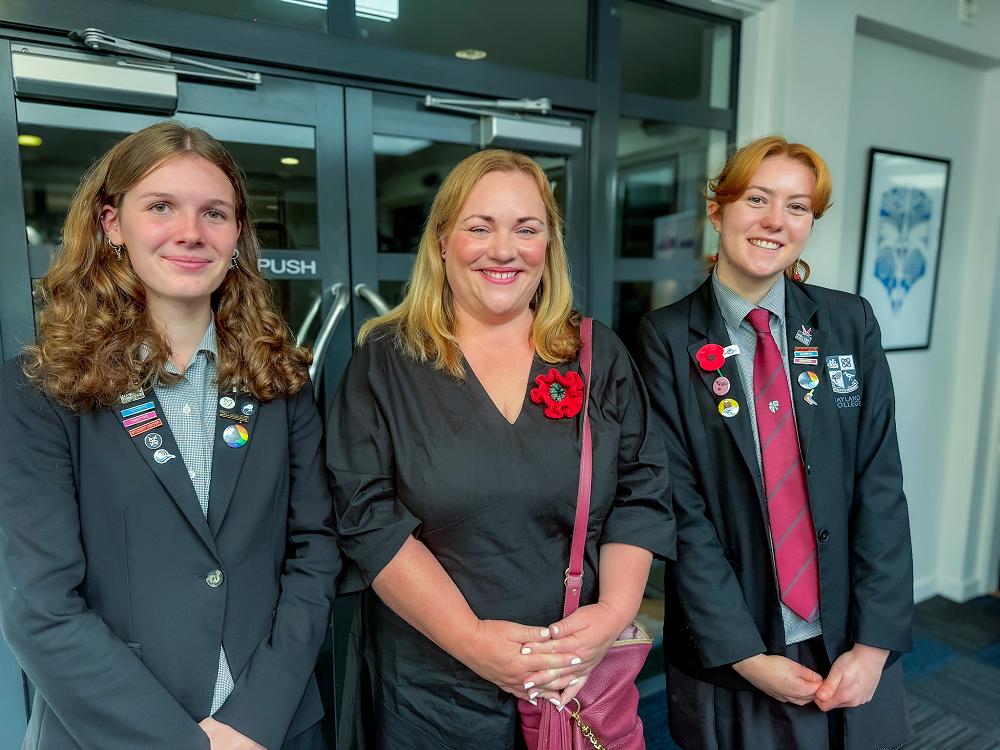Annabel Batt gave a moving speech at the Stoke ANZAC Commemorative Service. Here is her message.
They shall grow not old, as we that are left grow old: Age shall not weary them, nor the years condemn. At the going down of the sun and in the morning – we will remember them.
110 years after World War 1 started, our world is still recovering from the weakening and horror of trench warfare. 110 years later, our people are still carrying the legacy of the First World War and the Second World War. Remembering is difficult, no matter what age you are. We are here today to remedy that. I am here today to help you remember. I want you to think about your relatives, friends, loved ones who were a part of either war. Their name on a memorial, their flesh lost in that soil, their experience left unspoken. A lot of great storytelling has come from war- people who have lived to tell the tale of something either heroic, horrifying, ironically funny or heartwarming. Boy, do I have a story for you today.
Many great war films have been made based on true events. Some of you may have watched the 1963 ‘epic war film’ “The Great Escape”. Set at Berlin’s Prisoner of War camp Stalag Luft III during World War 2, it tells the story of one of the greatest Prisoner of War escapes in history.
The Nazis believed that Stalag Luft III was escape proof- they had built it designed for known escape artists. The buildings were lifted off the ground, microphones were dug 9 feet underneath the fences to pick up noise, and the camp was built on top of sand so it was difficult to tunnel under. A swag of Allied airmen still believed they had the ingenuity.
600 prisoners of war in Stalag Luft III in 1943 dirtied their hands and got to work. They built three tunnels, each planning to stretch 300 feet to where the camp’s perimeter stopped, under the cover of a forest. They nicknamed the tunnels Tom, Dick, and Harry. Burrowing underneath a trap door below a constantly-lit heating stove, they dug down 30 feet to be out of reach of the underground microphones. They would strip naked to avoid stains on their clothing from the yellow sand. These men dug out 1000 tons of sand, stuffing it into their socks and slowly dispersing it on the ground in the gardens. The prisoners stripped 4000 beds of wood for ladders, stuffed 1700 blankets against the walls to muffle the sounds, and converted more than 1400 powdered milk tins into lamps and tools.
Eventually Tom, Dick, and Harry began to be quite long- so they strung up a line of lights using a stolen wire that was hooked up to the camp’s electrical supply. With the lengthening of the tunnels, oxygen levels began to drop, so the men created an air pump system. Even an underground trolley was railed up to make resource transport easy.
However there was another issue- how did the Nazis not catch them? The men had created a secret code system to warn the other prisoners of an approaching guard, such as a subtle fiddling with a shoelace or turning a page of a book. The Nazis eventually discovered Tom. After demolishing it, they celebrated hard knowing that they had successfully ruined the Allied Prisoner’s plan. Instead, the men turned Dick into a storage space and focused all of their attention on Harry to fasttrack the escape. Their plan was to break out 200 Prisoners of War.
On the night of the 24th of March 1944, the plan went into action- but as the first man breathed in his first lungful of freedom, he realised that their tunnel stopped a few feet short of the protective cover of the forest. They had to make a mad dash. 78 men were able to escape from the tunnel that night. 50 of those escaped were re-captured and executed.
It really highlights the comradery and community associated with war, how these men worked together to help each other – how they strove for freedom when they knew the success gap was small. I think it’s wonderful to recognise that despite the overall negative association of war, there have been some gorgeous gaps of positivity coming from it.
However, I’m not quite done yet…
Many of you will know of the road that runs toward Nelson Airport, Trent Drive. Just a road, right? That road is named after a man named Leonard Trent, who was a New Zealand aviator in the Second World War and a recipient of the Victoria Cross. He was born here in Nelson. In 1943, Trent became a prisoner of war in Stalag Luft III. Here, he was one of the primary operators behind the Great Escape. Leonard Trent was the 79th person to escape the tunnel and therefore the first person to be caught by a German guard. Trent was placed in solitary confinement and held again as a prisoner of war until the Axis Powers’ defeat in 1945. Trent managed to survive the war and come back to New Zealand and Nelson eventually. And he had a road named after him. It’s said to be one of the greatest war escapes in history- and we have a local hero’s legacy in that. We have all driven down that road at some time or another- yet it’s unknown among the Nelson community the story behind that name. The remembering of our people and their unique experience in either war can be considered as disappointing. I’m here right now. You are here right now. We are here once a year. We are missing out on some wonderful, charming, gory, saddening, and engrossing stories. War has multitudes of lessons to teach us, and I believe that we need that now more than we ever have before. So next time you make your way down to the airport along Trent Drive, think about Leonard Trent. Think about him and all the men who were brave enough to be involved in the greatest prison escape in history. Think about all the other stories yet to be uncovered. All of the remembering that is yet to be done.
By ������Ƶ




